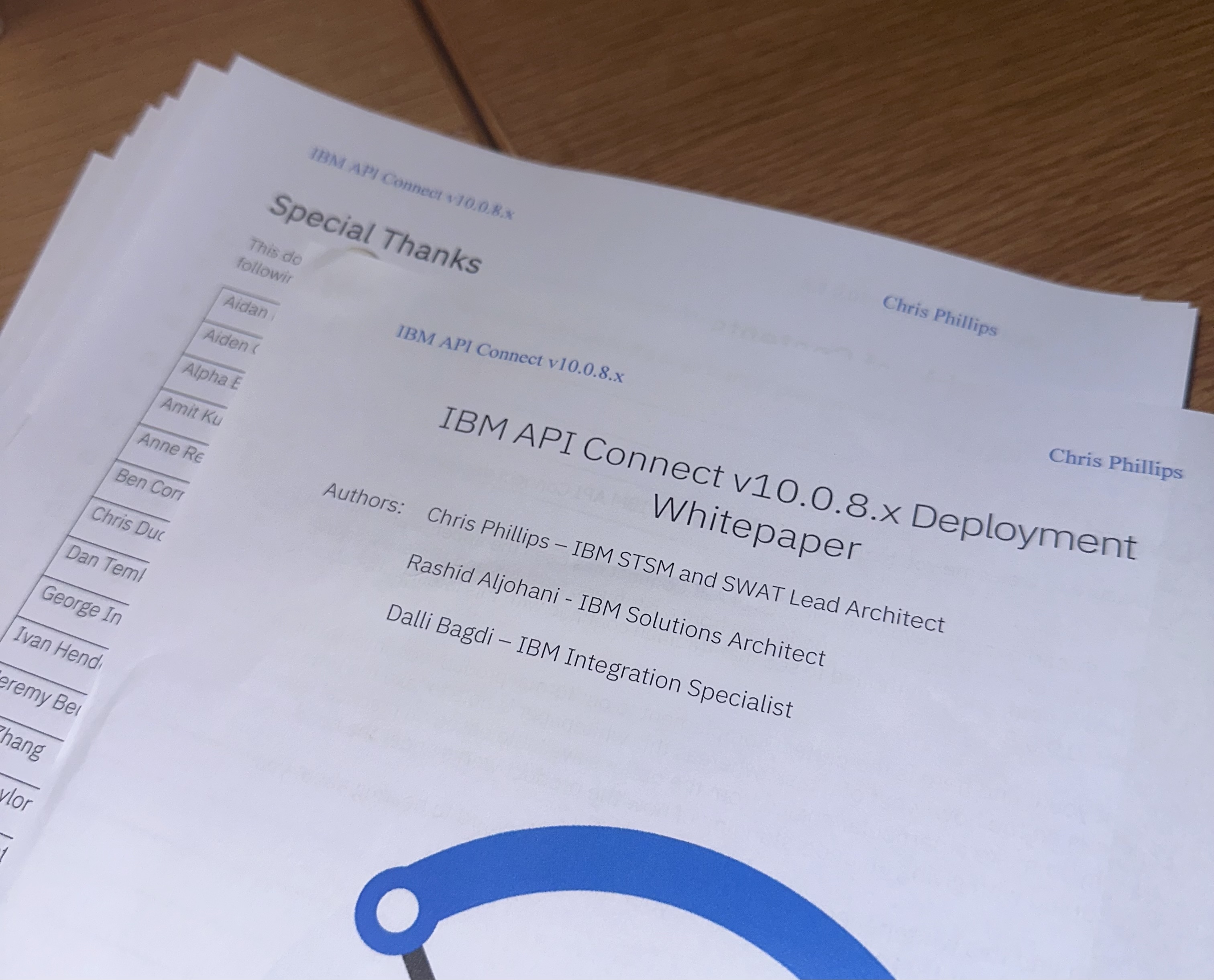| API CONNECT | |
 | Dates for your Diary |
| Guest Post by Chris Phillips | |
|
This is not announcement, all these dates have been already announced by IBM but I am posting this to highlight. I have shared links to where the information is available. Please confirm all information with your IBM rep if you have any concerns. Please note any changes to the information may not be updated on this blog so look at the provided links for the up to date information.
|
|
|
|
|
| API CONNECT | |
 | API Connect - Filtering requests by source IP with the API Gateway. |
| Guest Post by Chris Phillips Amit Kumar Singh | |
|
I am often asked if there is a way we can limit the range of IPs that we accept calling an API Gateway. This can be done with a GlobalPolicy and a little GatewayScript. Amit Kumar Singh from my team built some GatewayScript that will do this check. |
|
|
|
|
| API CONNECT | |
 | API Connect and OpenTelemetry |
| Guest Post by Amit Kumar Singh Chris Phillips | |
|
This article will explain how to enable Open Telemetry on API Connect 10.0.8.0 with DataPower 10.6.0.1. In order to apply these settings today, a GW extension must be used. This article will explain the steps to build the gateway extension. Thanks to Zach Groseclose and Ben Stern for assisting with this. For an introduction to OpenTelemetry please refer to our previous article on OpenTelemetry for AppConnect https://chrisphillips-cminion.github.io/ace/2024/04/22/ACE-Otel.html |
|
|
|
|
| API CONNECT | |
 | IBM APIConnect WhitePaper 10.0.8.x |
|
For the last year a small team and I have been updating the API Connect WhitePaper to cover changes between 10.0.1 and 10.0.8. The previous versions of this WhitePaper have assisted clients, IBMers and Business Partners from around the world deploying and understanding IBM API Connect. For this release we have changed our approach to deployment patterns to ensure that we could accurately show the flexibility of the product while at the same time provide a clear cookbook of options. Our intention is not to make our audience wait another 2.5 years for the next version, we are intending to update this every few months as new function is provided that makes sense for us to include. To download a copy please head over to IBM Communities.
|
|
|
|
|
| API CONNECT | |
 | Runing Asynchronous code in API Connect Gatewayscript policy |
|
A client asked how they can make two invokes in API Connect asynchronous. This is not possible with the invoke policies as they must always be synchronous. However it can be done with JavaScript/GatewayScript. |
|
|
|
|
| API CONNECT | |
 | Creating a rate limit object in DataPower |
| Guest Post by Chris Phillips Amit Kumar Singh | |
|
When using the rate limit policy on the Assembly you need to first create a rate limit in datpower in the API Gateway object. This must be done via a GatewayExtension to stop the policy being removed when a publish request is done from API Connect. This article will show you to create the rate limit objects in DataPower using a gateway extension. We will create a rate limit called |
|
|
|
|
| API CONNECT | |
 | Take offline the API Manager 10.0.5.x in OpenShift and Kubernetes |
|
While testing disaster recovery it is advisable to take offline the primary API Manager. This instructions will cover OpenShift and Kubernetes. |
|
|
|
|
| API CONNECT | |
 | Setting an invoke proxy |
| Guest Post by Chris Phillips Trey Williamson | |
|
Setting a downstream proxy is often a requirement when API Connect needs to make calls to the invoke downstream services on the internet. |
|
|
|
|
| API CONNECT | |
 | MultiPart APIs - Part 2 - Example use |
| Guest Post by Chris Phillips Steve Linn | |
|
In part 1 we discussed what a multipart API was and how it can be parsed in API Connect. In this part we will take that knowledge and apply it to a real situation. Scenario: Upload two images, validate that the images are png and that the size is less then 1MB. |
|
|
|
|
| API CONNECT | |
 | MultiPart APIs - Part 1 - What are they? How can I access the elements in API Connect. |
| Guest Post by Chris Phillips Steve Linn | |
|
MultiPart API calls allow multiple sets of data to be sent to an API as individual items. If you have a series of images and text you need to upload you could write a curl command similar to
|
|
|
|
|

|
| ABOUT | APICONNECT | API | DATAPOWER | OPENSHIFT | EVENTSTREAMS | INTEGRATION | DAY2-OPS | ACE |


